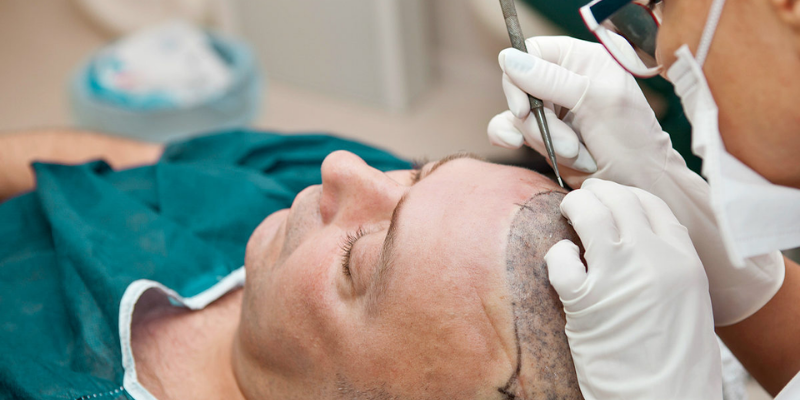The FUE method frequently uses method in hair transplantation, so what is FUE hair transplant?
Over time, the hair that has been worn out starts to fall out. In addition to genetics, stress, seasonal changes, and hormonal problems can also cause hair loss. It is also well-known that hair loss is exacerbated by ageing.
As well as making a person feel elderly, losing their hair may make them feel insecure. Hair transplantation can be used to restore the lost hair to its former glory. The FUE hair transplantation has left you with hair that is at least as thick and healthy looking as it was before. Hair transplantation is performed using a variety of ways. However, FUE hair transplantation is the most successful approach despite its lengthier session time.
What Is FUE Hair Transplant?
When asked what is FUE hair transplantation, it will be useful to give information about the content of the method. It is one of the most popular hair transplant methods in the world. This procedure does not include any scalp incisions or skin piercings.
An acronym for Follicular Unit Extraction is FUE. In 1988, 1 mm punches utilize for the first time in Japan. Medical journals first reported the procedure in 2002.
When using the FUE technique, the hair follicles are removed from the epidermis and transplanted one at a time in the target region. Hair follicles are removed from the donor region and transplanted one by one to the target location in the same manner. Consequently, the implantation of hair follicles necessitates the need for more sessions than other techniques. Instead of punches, today’s technique uses a micromotor.
FUE hair transplantation is a frequent procedure. It’s vital to know how to apply this approach.
What Is FUE Hair Transplant: Hair Transplant Techniques with FUE Method
Micro FUE Hair Transplant Technique
Essentially, it’s an enhanced version of the manual FUE method. Hair follicles are removed using a micro-tip device in the micro hair transplant method. In this approach, small motors with tiny tips are employed. As a general rule, these tips are designed to drill holes in the range of 0.66 to 0.90 millimetres. To eliminate hair follicles and their surrounding textural components, micro-circles are opened in the scalp.
Sapphire FUE Hair Transplant
Neither Saffir FUE nor Micro FUE are technical methods. A subset of the FUE method, they are. This procedure differs mainly in that it uses sapphire-based tips rather than metal ones. As a result of its ability to open tiny chambers in the scalp, it is great for reducing crusting. It also helps to speed up the healing process. Compared to other needle architectures, microneedles with sapphire tips are significantly healthier.
A sub-innovation of the FUE method, Soft FUE hair transplantation is referred to as a sub-technology of FUE hair transplantation. A soft FUE procedure is one in which the patient is sedated but not unconscious during the procedure. There is no loss of consciousness with this method, but you can undergo a hair transplant without any discomfort. To inhibit behaviours such as going to the bathroom and talking, sedatives are not the sort of drugs to use.
Stages of FUE Technique: What is FUE Hair Transplant
Local anaesthetic is used throughout the operation. After preparing the region where the hair will be transplanted, the hair follicles in good condition are gathered one at a time. With the FUE motor, tiny incisions (0.6 mm to 0.8 mm) are used for root harvest. A few hairs are present in the follicles that have been received (Graft). The roots must not be harmed at this time. During hair transplantation, hundreds of roots will be taken from the donor area, therefore the size of the tip utilized has an impact on the healing process.
After all of the hair roots have been gathered, planting may begin. In order for the sowing procedure to take place, channels must be opened with great care. Just as important as root harvesting is root canal opening.
It has lately become more popular to open the canal using the side slit approach rather than the punch method because it creates incisions that are ideal for the hair structure as well as openings that are appropriate in size and length for the hair follicle. In hair transplantation, the regeneration rate of the transplanted hair is affected by the size and depth of the channels.
It’s also vital to consider how the hair follicle will be implanted in relation to the angle of the canal. When it comes to replicating a natural hairdo, angles are crucial, and each region of the head should be treated differently. Hair will not assume the correct form if it is not well conditioned before it is cut. Naturalness can also be captured by determining where the hairline is. With the right proportions, you should compute the forehead and the hairline.
Healing Process After Fue Hair Transplant
Following a Fue Hair transplant, there are a number of steps that the patient should do. As a result of extracting the roots and transplanting them to the balding region, several reactions might be noticed. After planting, these responses are varied. Although these responses may feel uncomfortable, it is important to keep in mind that they are part of the healing process since numerous tiny holes form in the scalp for hair transplantation. Symptoms of this nature experience by everyone who has undergone a hair transplant, regardless of whether they are long-term or short-term.
During the process of removing the hair follicles and preparing the channels where the roots will be placed, tiny holes are drilled into the scalp. They produce clots in locations where the wound is situated by tissue after the surgery in order to repair the body wound. The body must go through the crusting process in order to heal the injury. When it comes to hair transplant recovery, crusting is typical.
In the aftermath of hair transplantation, crusting will occur, and itching from crusting is one of the symptoms that may bring discomfort to patients as they recuperate. As the tissue heals, more blood will be pumped through the region, increasing the amount of blood flow. Whenever the crusts start to break off, the scalp will begin to itch to get rid of the skin as quickly as possible. Dehydrated skin is more prone to this issue. After a long period of itching, the transplant doctor should be notified.
Let Us Get a Perspective on ‘What Is FUE Hair Transplant?’
Are you in the mids of asking Google, “What is FUE hair transplant?” FUE Hair Transplant is a minimally invasive procedure that can restore hair growth in areas of the scalp that have thinned or gone bald. The process involves taking individual follicular units from a donor site and placing them into recipient sites in the balding or thinning area of the scalp.

If you are wondering, “is FUE hair transplant safe?” FUE hair transplant is a safe and effective procedure for many people. The technology is constantly evolving to ensure the highest standards of safety. The doctors and healthcare staff administering the treatment are highly trained and experienced with performing this type of procedure. Furthermore, all the instruments used in FUE procedures are sterilized to further reduce any potential risks or side effects. Therefore, you can rest assured that a FUE hair transplant can be safely performed with desirable results.

Ensure you get the best FUE hair transplant experience possible. Post-procedure, patients must follow specific instructions to ensure optimal healing and new hair growth, including using prescribed medications, avoiding direct sunlight, keeping the scalp clean and avoiding any strenuous physical activities. Following these instructions will help you achieve successful long term results from your FUE hair transplant procedure, giving you a positive experience on “what is FUE hair transplant?”


